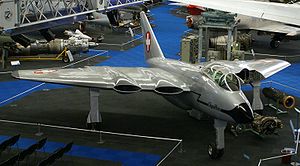EFW N-20 Video - Picture

|
|
EFW N-20 Aiguillon

Picture - The N-20 "Aiguillon"
Role: Fighter aircraft
National origin: Switzerland
Manufacturer: Eidgenx¶ssische Flugzeugwerke Emmen
First flight: 8 April 1952
Status: Cancelled
Primary user: Swiss Air Force
Number built: 1
The EFW N-20 "Aiguillon" (English: Stinger) was Switzerland's first jet fighter aircraft. The Swiss Federal Aircraft Factory developed a design for a four-engined swept winged fighter following the end of the Second World War. The aircraft was to be powered by four turbofan engines buried in the wings, with the bypass air feeding cold-air pipes each side of the engine, being routed through a combustion chamber where additional fuel could be burned as a form of reheat, or deflected though large slots on the upper and lower wings to act as aerodynamic flaps or thrust reversers. Two engines could be shut down in flight to increase range. It was planned that the N-20 would carry its armament in a detachable weapons bay, capable of carrying large loads of cannons, rockets or bombs.
It was initially planned that the aircraft's engines would be designed and built by the Swiss company Sulzer, but they abandoned this project in 1947, so the British Armstrong Siddeley Mamba turboprop was chosen as the basis for the N-20's engines, with the propeller reduction gear replaced by a low pressure compressor.
A 3/5 scale wooden glider, the EFW N-20.01 was built to allow testing of novel wing shape, this flying on 17 April 1948. Although the glider was destroyed in a landing accident, it had successfully proven the design, and was followed by a similar sized powered test aircraft, the EFW N-20.02 Arbalx¨te (Crossbow), powered by four 0.98 kN (220 lbf) Turboméca Piméné, mounted above and below the wings, this flying on 16 November 1951. It proved to have good manoeuvrability and reached a maximum speed of 750 km/h (466 mph).
The full scaled aircraft was estimated to have a maximum speed of 1,095 km (680 mph), but the initial converted Mamba, the SM-1, which was test-flown under a de Havilland Mosquito in 1948 and was the first turbofan to fly, did not generate adequate thrust, with considerable further work required for the definitive two-shaft SM-5 engine, which was meant to generate 14.7 kN (3,300 lbf) thrust. The prototype was completed in 1952 and, fitted with four SM-1 engines, flew briefly during a taxi test on 8 April 1952, but the development of the engine and the N-20 aircraft was cancelled soon afterwards.
Operators
Switzerland
Swiss Air Force
Specifications
Data from The Swiss N-20 Jet Fighter Bomber
General characteristics
Crew: 1
Length: 12 m (41 ft)
Wingspan: 12.60 m (41 ft 4 in)
Height: 3.7 m (12 ft)
Wing area: 53 m (570 sq ft)
Gross weight: 8,709 kg (19,200 lb)
Powerplant: 4 x— Armstrong Siddeley Mamba turbofan, 6.2 kN (1,400 lbf) thrust each
Bibliography
Haller, Ullrich. "The Swiss N-20 Jet Fighter-Bomber". Air Pictorial,July 1964. pp. 203-204.
Munziger, Ernst. Dx¼sentriebwerke. Luzern:Baden Verlag, 1991. ISBN 3-85545-056-0.
Schx¼rmann, Roman. Helvetische Jx¤ger. Dramen und Skandale am Militx¤rhimmel. Zurich: Rotpunktverlag, 2009. ISBN 978-3-85869-406-5
EFW N-20 Pictures
More airplane videos.
Source: WikiPedia